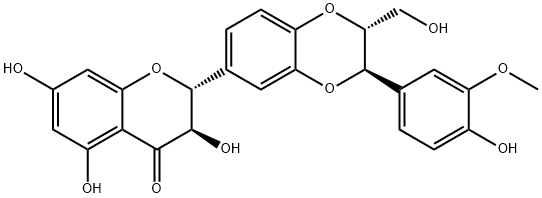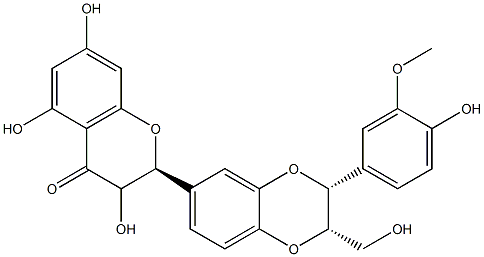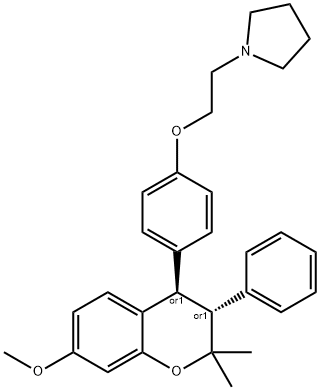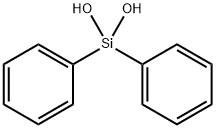A0616556
SilybinmixtureofSilybinAandB
Synonym(s):
(2R,3R)-3,5,7-Trihydroxy-2-[3-(4-hydroxy-3-methoxyphenyl)-2-hydroxymethyl-2,3-dihydrobenzo[1,4]dioxin-6-yl]chroman-4-one;2,3-Dihydro-3-(4-hydroxy-3-methoxyphenyl)-2-(hydroxymethyl)-6-(3,5,7-trihydroxy-4-oxobenzopyran-2-yl)benzodioxin;flavolignans;Silibinin;Silybin
CAS NO.:
Empirical Formula: C25H22O10
Molecular Weight: 482.44
MDL number: MFCD00872186
EINECS: 245-302-5
| Pack Size | Price | Stock | Quantity |
| 10mg | RMB1353.60 | In Stock |
|
| others | Enquire |
Update time: 2022-07-08
PRODUCT Properties
| Melting point: | 164-174°C |
| Boiling point: | 793.0±60.0 °C(Predicted) |
| alpha | D20 +11° (c = 0.25 in acetone + alcohol) |
| Density | 1.527±0.06 g/cm3(Predicted) |
| storage temp. | -20°C |
| solubility | Acetone (Sparingly), DMSO, Methano (Sparingly) |
| form | Solid |
| pka | pKa 6.42±0.04 (Uncertain) |
| color | Pale Yellow |
| Water Solubility | 54mg/L(24.99 ºC) |
| Merck | 13,8607 |
| Stability: | Stable. Incompatible with strong oxidizing agents, strong bases. |
| LogP | 4.232 (est) |
| CAS DataBase Reference | 22888-70-6(CAS DataBase Reference) |
Description and Uses
Silybin, also known as silibinin, is the principal biologically active constituent of the silymarin complex (about 70–80%) and is a mixture of silybin A and silybin B. Pharmacological research demonstrated that silybin has shown pleiotropic biological properties, including potent antioxidant, anti-inflammatory, anticancer, antidiabetic, hepatoprotective, neuroprotective, antiviral, antimicrobial and immunosuppressive activities. Silibinin demonstrates promising anticancer effects in vitro and in vivo[1].
Labelled Silybin (S465850). Hepatoprotectant.
Safety
| Symbol(GHS) |  GHS07 |
| Signal word | Warning |
| Hazard statements | H302 |
| Precautionary statements | P264-P270-P301+P312-P501 |
| Hazard Codes | Xi |
| Risk Statements | 36/37/38 |
| Safety Statements | 26-37/39-24/25-22-36 |
| RIDADR | 3172 |
| WGK Germany | 3 |
| RTECS | DJ2981770 |
| HS Code | 29329990 |
| Toxicity | LD50 intravenous in mouse: 1056mg/kg |





